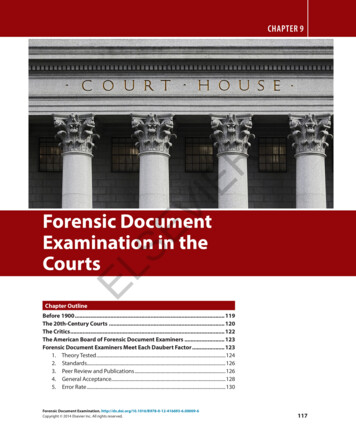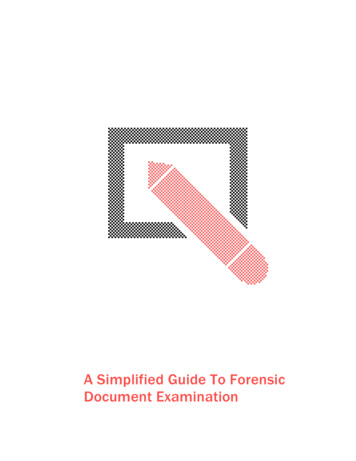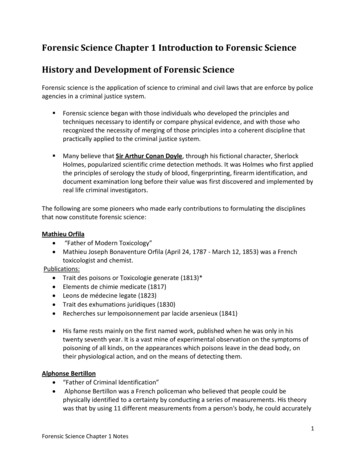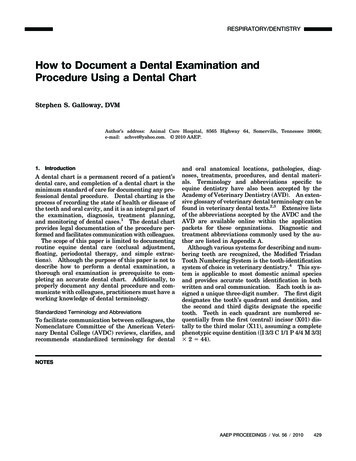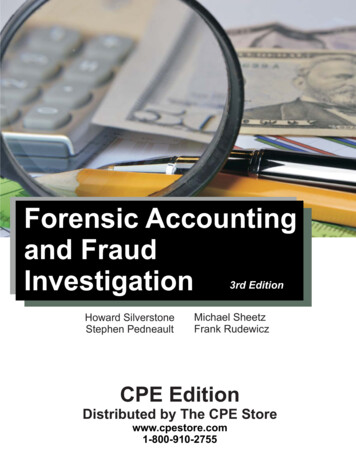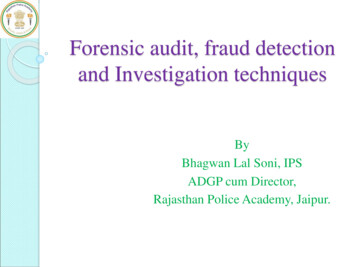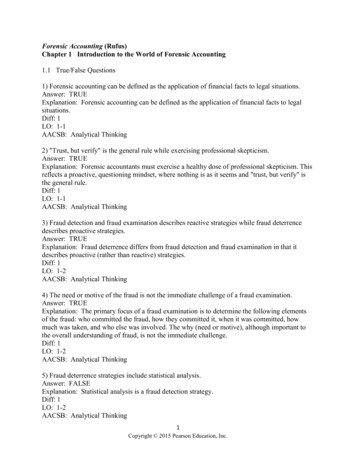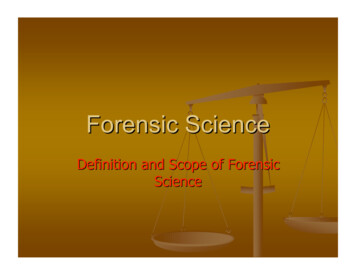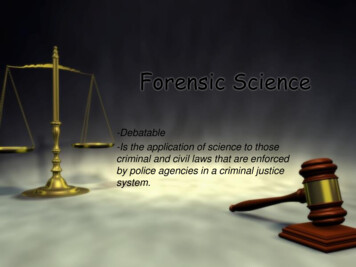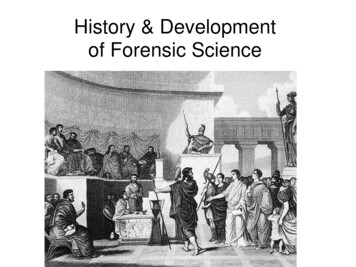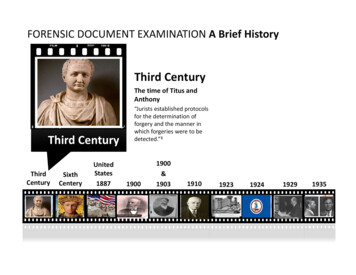
Transcription
FORENSIC DOCUMENT EXAMINATION A Brief HistoryThird CenturyThe time of Titus andAnthonyThird Jurists established protocolsfor the determination offorgery and the manner inwhich forgeries were to bedetected.”119001900&190319101923192419291935
FORENSIC DOCUMENT EXAMINATION A Brief HistorySixth CenturyJustinian CodeSixth Established furtherguidelines for the using ofhandwriting comparisons inthe courts. A judge could inhis discretion request personswith special skill in writing toperform an examination ofquestioned writing and givetestimony as the theauthenticity of thequestioned text.” 119001900&190319101923192419291935
FORENSIC DOCUMENT EXAMINATION A Brief HistoryFast Forward to theUnited StatesBell v Brewster( 0 N.E. 679,(106 9 44 OhioOhi St.S 690)USA 1887ThirdCenturySixthCenteryUnitedStates1887“The Ohio Supreme Courtrecognized the importance ofhandwriting as a means ofidentifying a person.person ” 2 Utilizingstandards of comparison, expertcomparative analysis and opiniontestimony regarding writing toestablished questioned writing asprepared by a specific writer.19001900&190319101923192419291935
FORENSIC DOCUMENT EXAMINATION A Brief History1900Daniel T. Ames“Ames on Forgery”One of the earliest treatisesby the founder of thePenman’s Art Journal,penmanship author and“ExaminerExaminer of ContestedHandwriting in Courts es188719001900&190319101923192419291935
FORENSIC DOCUMENT EXAMINATION A Brief History19001903New York v R. B.MolineauxMatter of Rice(the Rice‐Patrick case)Notable early criminal caseinvolving the testimony ofseveral handwriting experts.Roland Molineaux, a chemist,was tried for the poisoningmurder of a woman,Katherine Adams.Notable early forged Will casein New York. The result ofthis case indirectly led to theRice Institute foundation.1900 & 001900&190319101923192419291935
FORENSIC DOCUMENT EXAMINATION A Brief History1910Albert Sherman Osborn“Questioned Documents”A comprehensive text whichestablished a greater focus onnot only the examination ofhandwriting and signatures,but of other types ofevidence appearing ondocuments including paper,ink, typewriting tates1887Albert S. Osborn also, duringthe early part of the century,began to invite otherdocument examiners to hishome in Upper Montclair, NJ.These meetings were thebeginnings of what wouldbecome the American Societyof Questioned 91935
FORENSIC DOCUMENT EXAMINATION A Brief HistoryFrye v United States293 F, 1013 (DC Cir. 1923)The FryeStandardAlthough this decision cameabout as a result of the use ofpolygraph testing, it was thestandard by which experttestimony was allowed fordecades. Among otherthings, it demanded generalacceptance of expertise tedStates188719001900&190319101923192419291935
FORENSIC DOCUMENT EXAMINATION A Brief HistoryVirginiaAdams v Ristine122 S. E. 126, 138 Va 273,31 A.L.R. 1413“Chock‐full of document lawpoints, covering manyquestions includingqualificationslifi tioff experts,tscope of cross‐examinationand use of photographicevidence.” 2This was a landmark case dueto the number of issues whichwere addressed dealing withexpert testimonyiini theh field.fi 19001900&190319101923192419291935
FORENSIC DOCUMENT EXAMINATION A Brief HistoryJohn H.WigmoreScientific Crime Detection Laboratory“The organization of the first forensic science laboratory, theScientific Crime Detection Laboratory in Chicago, IL, began in1929. It started under private endowment, but within one ortwo yyears,, because of the influence of Professor John H.Wigmore, it was affiliated with Northewestern UniversitySchool of Law. “ “This laboratory was modeled aftermultidisciplinary European laboratories and included aquestioned document es188719001900&1903191019291923192419291935
FORENSIC DOCUMENT EXAMINATION A Brief HistoryState of NJ v Bruno RichardHauptmannThe Lindbergh kidnappingAlbert S. Osborn, Albert D. Osborn, Elbridge W. Stein, ClarkSellers, John H. Tyrrell, H. J. Walter, Harry Cassidy and Dr.Wilmer Souder (the only public examiner), were consultedindependentlypy and opinedpHauptmannphad preparedp pmultiplepransom demand 188719001900&190319101923192419291935
FORENSIC DOCUMENT EXAMINATION A Brief HistoryAmerican Society ofQuestioned DocumentExaminersiFormally FoundedWith Albert S. Osborn presiding, the ASQDE was formallyestablished. Membership in organization was entirely byinvitation. Its meetings were completely educational in scope,and annual attendance as well as full participation in theprogram were an absolute requirement for a continuinginvitation The ASQDE is consideredinvitation.considered, by manymany, to be theprimary national organization disseminating research in theUnited States.1942194219561959197719821989
FORENSIC DOCUMENT EXAMINATION A Brief HistoryKidnap/Murderid/dOf Peter WeinbergerPeople v John LaMarca(New York)FBI experts sift through75,000 police recordsignatures, expanding thesearch to probation records.John LaMarca was identifiedthrough federal district courtrecords.d19561956194219561959197719821989
FORENSIC DOCUMENT EXAMINATION A Brief HistoryJames V. P. Conway“Evidential Documents”A well regarded text byConway of the PostalInspector in charge of the SanFrancisco IdentificationLaboratory (USPS). The bookwas a completelguide,id bbutamong the first to cover thesubject matter with brevityand considered an excellentintroduction to the field forthe trial lawyer.19561959194219561959197719821989
FORENSIC DOCUMENT EXAMINATION A Brief HistoryAmerican Board ofForensic DocumentExaminersOfficial FormationThe ABFDE’s stated objectives are two‐fold: toestablish, maintain and enhance standards ofqualification for those who practice forensic documentexamination, and to certify applicants who comply withABFDE requirements for this expertise. In doing so, theBoard aims to safeguard the public interest by ensuringthat anyone who claims to be a specialist in forensicdocument examination does, in fact, possess thenecessary skills and qualifications19561977194219561959197719821989
FORENSIC DOCUMENT EXAMINATION A Brief HistoryOdOrdwayHiltHilton“Scientific Examination ofQuestioned Documents – RevisedEdition”Hilton’s book, with the publication of theRevised Edition, became the pre‐eminenttraining text of the modern documentexaminer. Hilton’sl ’ book,b k alonglwithh thehwritings of Dr. Wilson Harrison, Osborn,Conway; and then later Huber, Ellen,Huber/Headrick; and most recentlyKelly/Lindblomy/would form the textsutilized in training and the guide forpublished protocol development.1942195619591977198219821989
FORENSIC DOCUMENT EXAMINATION A Brief HistoryD bDenbeaux,SaksS k & RiRisingeri“Exorcism of Ignorance as a Proxy forRational Knowledge: The Lessons ofHandwriting Identification‘Expertise’”The University of Pennsylvania Law Reviewarticle which focused attention on forensicdocument examination and particularlyhandwriting examination. Largely criticizedby the field, the article certainly can becredited with ending the complacency ofthe field with respect to empirical researchresearch,protocol development and other issues.1942195619591977198919821989
FORENSIC DOCUMENT EXAMINATION A Brief HistoryBibliBibliographyh1Thornton,John I. and Edward F. Rhodes, Brief History of Questioned Document Examination,Identification News , January,19862Scott,3Charles C., Some Landmark Cases on Document Law, ASQDE Annual Meeting, Houston, Texas,August, 1981Hilton, Ordway, History of Questioned Document Examination in the United States, Journal of ForensicScience, V 24, N 4, October 1979, pp 890-897Hilton, Ordway, The Evolution of Questioned Document Examination in the Last Fifty Years, (copyright byauthor), Landrum, South Carolina, 19871989ASQDE, American Society of Questioned Document Examiners: History and Background, ASQDE, 1990Niyogi, S.K., Ordway Hilton, Discussion of History of Questioned Document Examination in the United StatesJournal of Forensic Science, Vol 25, No 3, July, 1980, pp 465-469Walter, Herbert J., The History of Handwriting in the United States During the Past 100 Years, ASQDE AnnualMeeting Los AngelesMeeting,Angeles, CACA, 1947Conway, James V.P., A Brief History of the American Society of Questioned Document Examiners, Journal ofthe American Society of Questioned Document Examiners, VOL. 1, NO. 1, PP. 2-3, June,1998Risinger, Michael D., Mark P. Denbeaux & Michael J. Saks, Exorcism of Ignorance as a Proxy for RationalKnowledge: The Lessons of Handwriting Identification “Expertise,” University of Pennsylvania LawReview, Vol 137, pp 731-2361, 1989
Albert S. Osborn, Albert D. Osborn, Elbridge W. Stein, Clark Sellers, John H. Tyrrell, H. J. Walter, Harry Cassidy and Dr. Wilmer Souder (the only public examiner), were consulted independently and opined Hauptmann had prepared multiple 1900 py pp ransom demand notes. 1935 1910 1924 1900 &
